Completely dormant in the winter, in the very early spring the leaves of the River Crinum emerge, forming a crown of long green straps. And then a green spear emerges rising to almost a metre in height as the buds start forming at the tip, eventually opening into white and pink lily-like flowers.
And with luck, a second or even third stem may emerge to produce another cluster of trumpet-shaped flowers. As the flowers mature, the long stalk reclines gracefully, eventually coming to rest on the ground. The flowers progress to become round pink fruits.
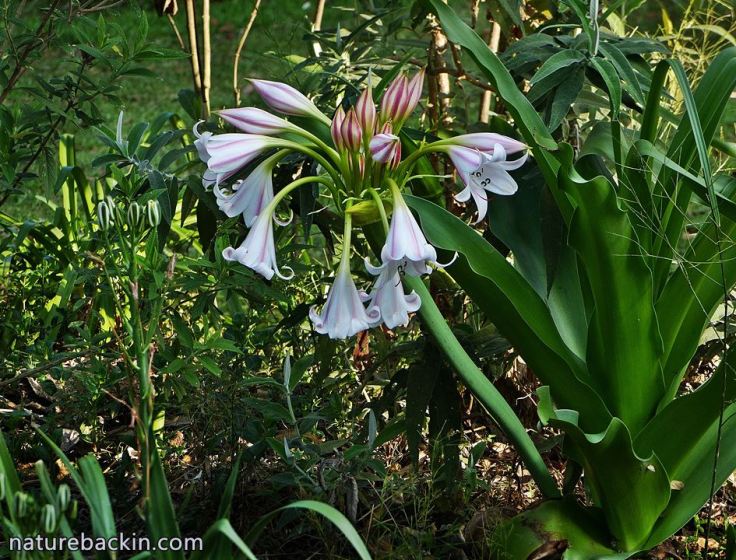
The River Crinum (Crinum macowanii ) is a tall and graceful presence in the garden
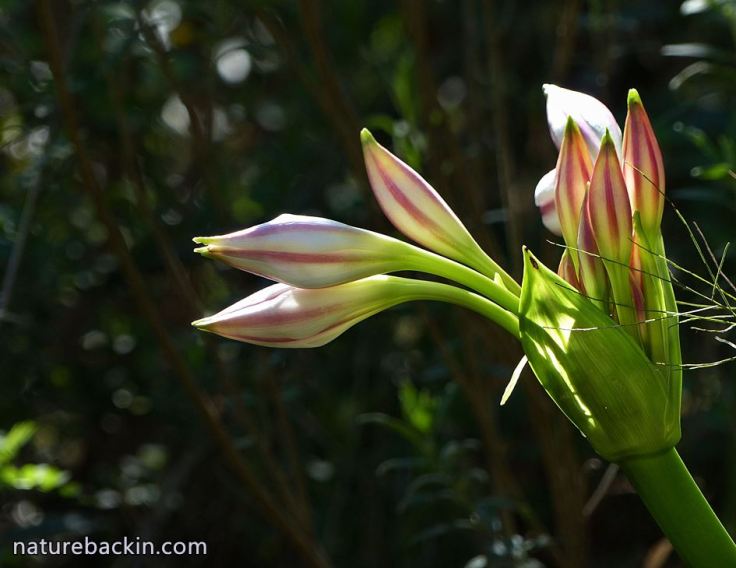
Initially emerging in a tight bunch, the buds gradually separate and elongate before opening, each in its own time

The striped buds, held high at the top of the long stem, are every bit as attractive as the fully opened flowers
In nature these plants grow from the coast to the mountains in a wide variety of habitats, including in grasslands in the wetlands and in the mountains, near rivers, as well as in woodland areas. It also grows in a variety of soils, including rocky and sandy soils. It occurs in many areas in southern Africa and northwards into East Africa.

The fact that the buds open successively adds to the showiness of the flowers
There are 22 species of Crinum in southern Africa, growing mostly in the summer rainfall areas. Crinum are part of the Amaryllidaceae family. They have a faint sweet scent that is at its strongest in the evening. It is thought that the flowers are pollinated by moths, although I have seen bees and other insects attracted to the flowers in our garden.
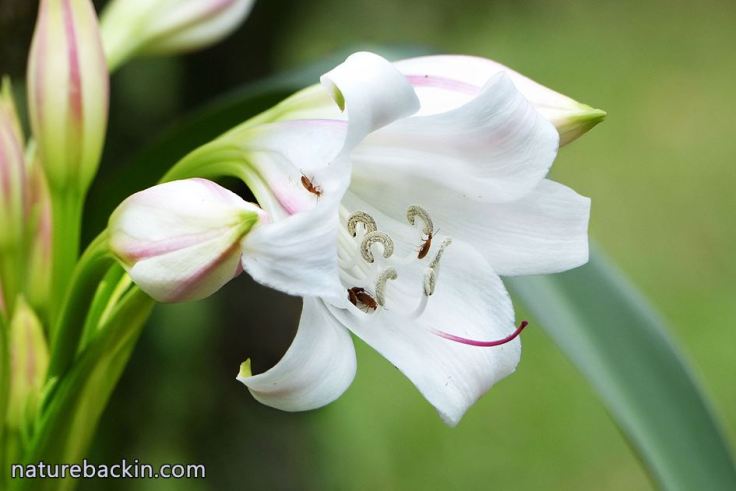
Small beetles attracted to the pollen
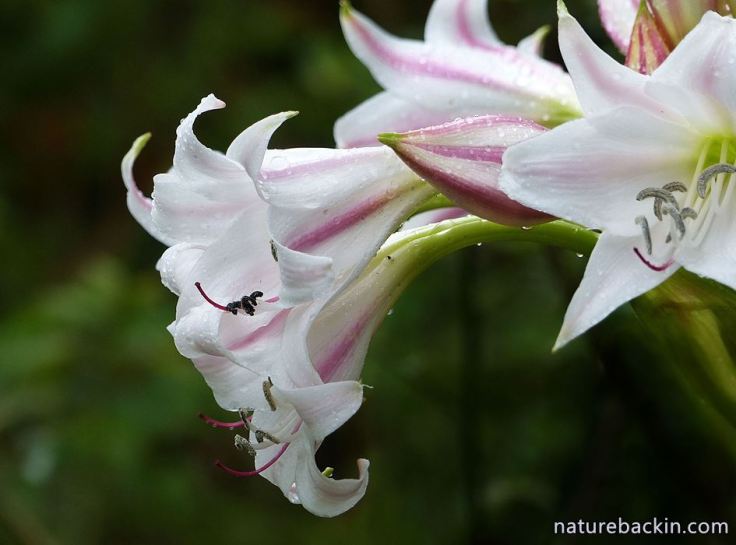
As the flowers mature, the tips of the petals curl back attractively
Although it is not yet a ‘near threatened’ species, the number of plants in the wild is declining. The bulbs are harvested and collected for the traditional medicines trade. In the preparation of medicine made from crinums, skill is required as the bulbs contain toxic alkaloids. Medicinal uses include making decoctions of the bulb to be taken orally and used to treat tuberculosis, rheumatic fever, and kidney and bladder infections. The boiled bulb is used as a compress and the leaves can be used to make poultices and as bandages.
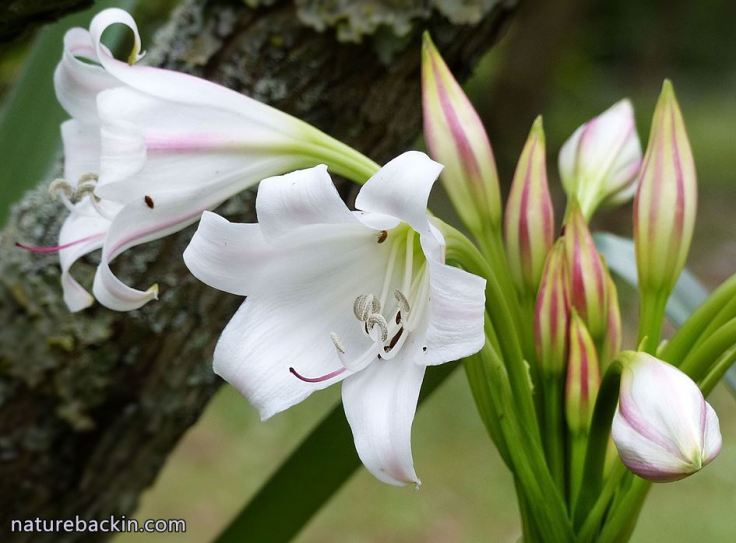
It is always cheering to see the River Crinum resurrecting from dormancy after surviving the dry winter and going on to flower in response to the spring rains. In our area it is one of those plants that thrives on benign neglect – my favourite kind of plant, with the added bonus of its exceptionally beautiful flowers.
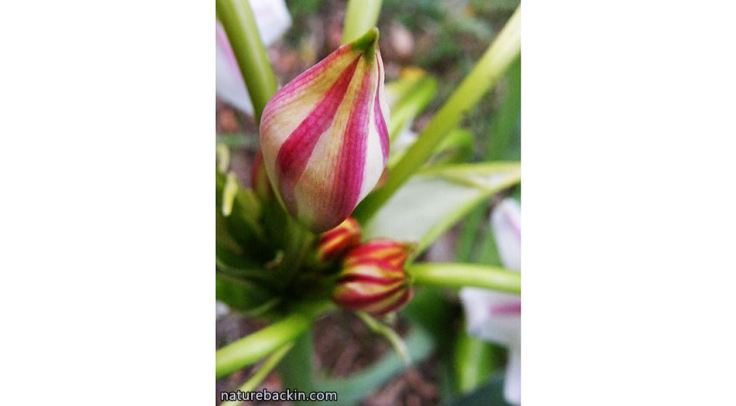
Sources: Notte, Alice. 2013. PlantZAfrica. South African National Biodiversity Institute (SANBI). http://pza.sanbi.org/crinum-macowanii; Pooley, Elsa. 1998. A Field Guide to Wild Flowers of KwaZulu-Natal and the Eastern Region. Durban: Natal Flora Publications Trust; Van Wyk, Ben-Erik and Gericke, Nigel. 2007. People’s Plants: A Guide to Useful Plants of Southern Africa. Pretoria: Briza
Posted by Carol

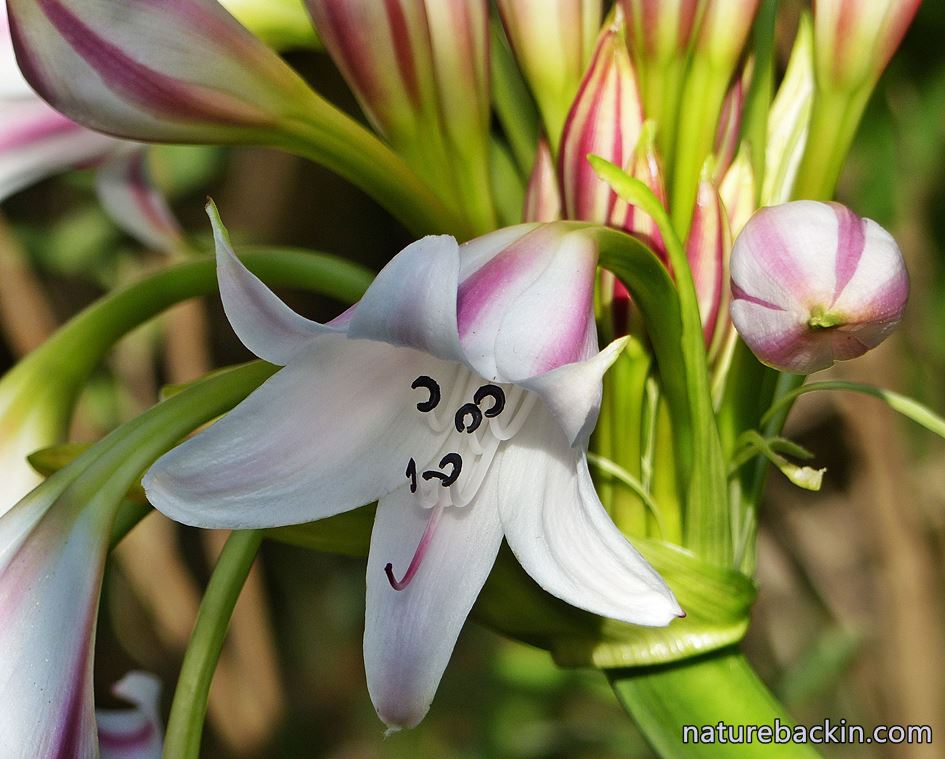







October 30, 2017 at 2:14 pm
Such a delicately lovely flower!
LikeLiked by 1 person
November 2, 2017 at 7:51 pm
Thanks – yes, both in colour and form.
LikeLike
October 28, 2017 at 10:29 am
How lovely. The buds look as striking as the blooms themselves. I thought they perhaps belonged to the amaryllis family which we of course, grow as showy indoor bulbs around Christmas time.
LikeLiked by 1 person
October 29, 2017 at 1:06 pm
Thanks Sandra. I also like the buds. Crinums and the South African amaryllis belong to the same family. I gather that the popular houseplant commonly referred to as an amaryllis is more correctly a ‘Hippeastrum’ (original plants from South America) though it also belongs to the the same family (the ‘Amaryllidaceae’), as does the daffodil 🙂 The history of the taxonomy and naming of the amaryllis and crinums seems to be interesting and complicated!
LikeLiked by 1 person
October 29, 2017 at 3:42 pm
This is fascinating, Carol, and as you say – complicated! Thanks for the info 🙂
LikeLiked by 1 person
October 28, 2017 at 10:22 am
You are a superb photographer, Carol, and you add such a special touch.
LikeLiked by 1 person
October 29, 2017 at 12:50 pm
Thanks so much Suzette. I so admire your photography and art and I am very touched by your comment.
LikeLike
October 26, 2017 at 11:41 pm
Lovely photos. It’s nice to enjoy spring again as winter approaches here😏
LikeLiked by 1 person
October 27, 2017 at 7:27 pm
Thanks Belinda. I do prefer the spring and the summer even though the winters here are nowhere near as extreme as where you are. Hope you will stay cosy in the coming months – hard to believe the seasons have turned full circle so soon.
LikeLiked by 1 person
October 27, 2017 at 7:48 pm
I know, it seems the warm weather is over before we know it. The fall colours are a nice consolation though.
LikeLiked by 1 person
October 26, 2017 at 7:59 pm
Your spring plants are clearly so very different from our familiar daffodils and primroses!
LikeLiked by 1 person
October 27, 2017 at 7:23 pm
Wordsworth would likely be amazed 🙂
LikeLiked by 3 people
October 26, 2017 at 7:51 pm
What a beautiful flower – I love the striped buds. Orange crinums flower here as houseplants in winter. Because they are slow growing, they are expensive to buy. But they will live forever. I have a friend whose plant belonged to her grandmother.
LikeLiked by 1 person
October 27, 2017 at 7:22 pm
Thanks Eliza. How amazing to pass on a houseplant through the generations. I have not see the orange crinum sold as a houseplant here – I guess that it is a cultivated hybrid.
LikeLiked by 1 person